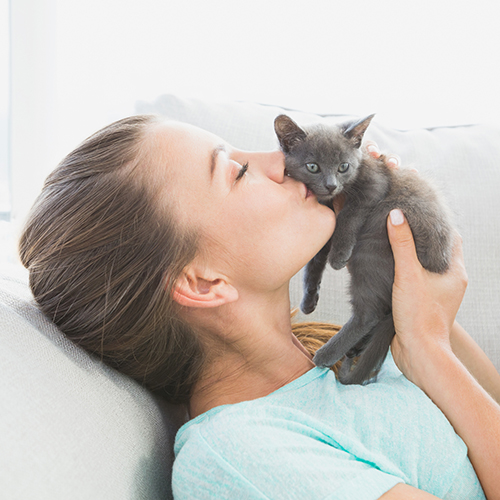Special Report
States With the Most and Least Cat Owners

Published:
Last Updated:

When it comes to cats, it won’t take you nine lifetimes to see how popular they are in the United States. These typically furry and cuddly animals were considered sacred in ancient Egypt. Today, with over 74 million cats living in over 36 million American households, many have welcomed our feline overlords — in real life and on the internet.
Only the continental U.S. was considered, and stray or feral cats, which are estimated to number well over 50 million, were not counted. Based on the latest data from the American Veterinary Medical Association, an estimated 30.4% of households own cats — or is it the cats that own the households?
The region with the highest cat-owning households per capita is New England — the area consisting of Connecticut, Maine, Massachusetts, New Hampshire, Rhode Island, and Vermont. With 35.0% of households, compare this to the 28.5% of households that own cats in the South Atlantic, the region with the lowest percentage of cat-owning households. Still, the states of the South Atlantic — Delaware, Florida, Georgia, Maryland, North Carolina, South Carolina, Virginia, and West Virginia — own the largest sheer number of cats as pets.
24/7 Wall St. ranked the states based on household cat ownership rates. With not even 25% of households, Utah is the state with the lowest share of cat-owning households. In Vermont, on the other hand, nearly 50% of households own at least one cat. Where do you think your state sits on the list?
Click here to see the states with the most and least cat owners.
To identify the states where cat ownership is the highest and lowest, 24/7 Wall St. analyzed the percentage of households that own cats in each of the contiguous U.S. states from the American Veterinary Medical Association’s U.S Pet Ownership & Demographic Sourcebook, 2012 edition, which contains the latest data available.
 Source: Thinkstock
Source: Thinkstock
48. Utah
> Cat-owning households: 24.6%
> Cat population: 455,000 (12th lowest)
> Avg. number of cats per household: 2.0 (22nd highest)
[in-text-ad]

47. New Jersey
> Cat-owning households: 25.3%
> Cat population: 1,468,000 (19th highest)
> Avg. number of cats per household: 1.8 (9th lowest)

46. Louisiana
> Cat-owning households: 25.9%
> Cat population: 877,000 (23rd lowest)
> Avg. number of cats per household: 2.0 (22nd highest)

45. Illinois
> Cat-owning households: 26.3%
> Cat population: 2,453,000 (7th highest)
> Avg. number of cats per household: 1.9 (19th lowest)
[in-text-ad-2]

44. Florida
> Cat-owning households: 27.3% (tied)
> Cat population: 4,375,000 (3rd highest)
> Avg. number of cats per household: 2.1 (14th highest)

43. Georgia
> Cat-owning households: 27.3% (tied)
> Cat population: 2,162,000 (10th highest)
> Avg. number of cats per household: 2.1 (14th highest)
[in-text-ad]

42. Alabama
> Cat-owning households: 27.4%
> Cat population: 1,252,000 (23rd highest)
> Avg. number of cats per household: 2.5 (2nd highest)

41. Rhode Island
> Cat-owning households: 27.6%
> Cat population: 212,000 (6th lowest)
> Avg. number of cats per household: 1.8 (9th lowest)

40. South Carolina
> Cat-owning households: 27.8%
> Cat population: 1,039,000 (24th lowest)
> Avg. number of cats per household: 2.1 (14th highest)
[in-text-ad-2]

39. California
> Cat-owning households: 28.3% (tied)
> Cat population: 7,118,000 (the highest)
> Avg. number of cats per household: 1.9 (19th lowest)

38. Texas
> Cat-owning households: 28.3% (tied)
> Cat population: 5,565,000 (2nd highest)
> Avg. number of cats per household: 2.2 (7th highest)
[in-text-ad]

37. Virginia
> Cat-owning households: 29.0%
> Cat population: 1,855,000 (12th highest)
> Avg. number of cats per household: 2.1 (14th highest)

36. Mississippi
> Cat-owning households: 29.1% (tied)
> Cat population: 668,000 (18th lowest)
> Avg. number of cats per household: 2.1 (14th highest)

35. New York
> Cat-owning households: 29.1% (tied)
> Cat population: 4,261,000 (4th highest)
> Avg. number of cats per household: 1.9 (19th lowest)
[in-text-ad-2]

34. North Carolina
> Cat-owning households: 29.5%
> Cat population: 2,220,000 (9th highest)
> Avg. number of cats per household: 2.0 (22nd highest)

33. Arizona
> Cat-owning households: 29.6%
> Cat population: 1,438,000 (20th highest)
> Avg. number of cats per household: 1.9 (19th lowest)
[in-text-ad]

32. Minnesota
> Cat-owning households: 29.7%
> Cat population: 1,264,000 (22nd highest)
> Avg. number of cats per household: 2.0 (22nd highest)

31. Maryland
> Cat-owning households: 29.8% (tied)
> Cat population: 1,677,000 (15th highest)
> Avg. number of cats per household: 2.6 (the highest)

30. Tennessee
> Cat-owning households: 29.8% (tied)
> Cat population: 1,749,000 (14th highest)
> Avg. number of cats per household: 2.3 (4th highest)
[in-text-ad-2]

29. Iowa
> Cat-owning households: 30.3% (tied)
> Cat population: 805,000 (21st lowest)
> Avg. number of cats per household: 2.2 (7th highest)

28. Nevada
> Cat-owning households: 30.3% (tied)
> Cat population: 625,000 (16th lowest)
> Avg. number of cats per household: 2.1 (14th highest)
[in-text-ad]

27. Arkansas
> Cat-owning households: 30.6%
> Cat population: 810,000 (22nd lowest)
> Avg. number of cats per household: 2.3 (4th highest)

26. Michigan
> Cat-owning households: 31.3% (tied)
> Cat population: 2,420,000 (8th highest)
> Avg. number of cats per household: 2.0 (22nd highest)

25. Nebraska
> Cat-owning households: 31.3% (tied)
> Cat population: 514,000 (14th lowest)
> Avg. number of cats per household: 2.3 (4th highest)
[in-text-ad-2]

24. North Dakota
> Cat-owning households: 31.4%
> Cat population: 174,000 (4th lowest)
> Avg. number of cats per household: 2.0 (22nd highest)

23. Connecticut
> Cat-owning households: 31.9%
> Cat population: 796,000 (20th lowest)
> Avg. number of cats per household: 1.9 (19th lowest)
[in-text-ad]

22. New Mexico
> Cat-owning households: 32.0%
> Cat population: 533,000 (15th lowest)
> Avg. number of cats per household: 2.2 (7th highest)

21. Missouri
> Cat-owning households: 32.2%
> Cat population: 1,653,000 (16th highest)
> Avg. number of cats per household: 2.1 (14th highest)

20. Colorado
> Cat-owning households: 32.3%
> Cat population: 1,191,000 (24th highest)
> Avg. number of cats per household: 1.9 (19th lowest)
[in-text-ad-2]

19. Oklahoma
> Cat-owning households: 32.6%
> Cat population: 1,041,000 (25th lowest)
> Avg. number of cats per household: 2.2 (7th highest)

18. Wisconsin
> Cat-owning households: 33.0%
> Cat population: 1,510,000 (18th highest)
> Avg. number of cats per household: 1.9 (19th lowest)
[in-text-ad]

17. Kansas
> Cat-owning households: 33.3% (tied)
> Cat population: 731,000 (19th lowest)
> Avg. number of cats per household: 1.9 (19th lowest)

16. Ohio
> Cat-owning households: 33.3% (tied)
> Cat population: 3,786,000 (5th highest)
> Avg. number of cats per household: 2.4 (3rd highest)

15. Montana
> Cat-owning households: 33.6%
> Cat population: 277,000 (8th lowest)
> Avg. number of cats per household: 2.0 (22nd highest)
[in-text-ad-2]

14. Delaware
> Cat-owning households: : 33.7%
> Cat population: 187,000 (5th lowest)
> Avg. number of cats per household: 1.7 (3rd lowest)

13. Pennsylvania
> Cat-owning households: 33.8%
> Cat population: 3,544,000 (6th highest)
> Avg. number of cats per household: 2.0 (22nd highest)
[in-text-ad]

12. Wyoming
> Cat-owning households: 33.9%
> Cat population: 144,000 (3rd lowest)
> Avg. number of cats per household: 1.9 (19th lowest)

11. Massachusetts
> Cat-owning households: 34.1%
> Cat population: 1,593,000 (17th highest)
> Avg. number of cats per household: 1.8 (9th lowest)

10. New Hampshire
> Cat-owning households: 34.2%
> Cat population: 309,000 (10th lowest)
> Avg. number of cats per household: 1.8 (9th lowest)
[in-text-ad-2]

9. Indiana
> Cat-owning households: 34.4%
> Cat population: 1,912,000 (11th highest)
> Avg. number of cats per household: 2.2 (7th highest)

8. Idaho
> Cat-owning households: 34.6%
> Cat population: 393,000 (11th lowest)
> Avg. number of cats per household: 2.0 (22nd highest)
[in-text-ad]

7. Kentucky
> Cat-owning households: 36.8%
> Cat population: 1,349,000 (21st highest)
> Avg. number of cats per household: 2.1 (14th highest)

6. West Virginia
> Cat-owning households: 38.1%
> Cat population: 628,000 (17th lowest)
> Avg. number of cats per household: 2.2 (7th highest)

5. Washington
> Cat-owning households: 39.0%
> Cat population: 1,844,000 (13th highest)
> Avg. number of cats per household: 1.8 (9th lowest)
[in-text-ad-2]

4. South Dakota
> Cat-owning households: 39.1%
> Cat population: 290,000 (9th lowest)
> Avg. number of cats per household: 2.2 (7th highest)

3. Oregon
> Cat-owning households: 40.2%
> Cat population: 1,185,000 (25th highest)
> Avg. number of cats per household: 2.0 (22nd highest)
[in-text-ad]

2. Maine
> Cat-owning households: 46.4%
> Cat population: 498,000 (13th lowest)
> Avg. number of cats per household: 1.9 (19th lowest)

1. Vermont
> Cat-owning households: 49.5%
> Cat population: 234,000 (7th lowest)
> Avg. number of cats per household: 1.8 (9th lowest)
A financial advisor can help you understand the advantages and disadvantages of investment properties. Finding a qualified financial advisor doesn’t have to be hard. SmartAsset’s free tool matches you with up to three financial advisors who serve your area, and you can interview your advisor matches at no cost to decide which one is right for you. If you’re ready to find an advisor who can help you achieve your financial goals, get started now.
Investing in real estate can diversify your portfolio. But expanding your horizons may add additional costs. If you’re an investor looking to minimize expenses, consider checking out online brokerages. They often offer low investment fees, helping you maximize your profit.
Thank you for reading! Have some feedback for us?
Contact the 24/7 Wall St. editorial team.